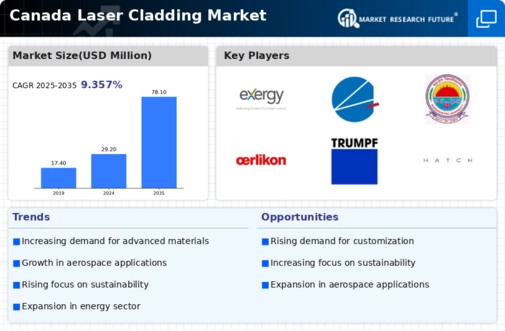Growth in Oil and Gas Industry
The oil and gas industry in Canada is a substantial driver for the laser cladding market. As companies strive to enhance the durability of drilling equipment and pipelines, laser cladding offers a solution to combat wear and corrosion. The industry has seen investments exceeding $100 billion in recent years, indicating a robust market for advanced technologies. Laser cladding can extend the life of critical components, thereby reducing operational costs and downtime. This trend suggests that as the oil and gas sector continues to evolve, the demand for laser cladding services will likely increase, further solidifying its importance in the market.
Advancements in Material Science
The field of material science is rapidly evolving, leading to the development of new alloys and composites that can be effectively utilized in the laser cladding market. These advancements enable the creation of components with superior properties, such as increased strength and resistance to extreme conditions. As Canadian industries adopt these innovative materials, the demand for laser cladding services is expected to rise. The potential for improved performance in sectors such as automotive and heavy machinery suggests a promising future for the laser cladding market. This trend highlights the importance of ongoing research and development in driving market growth.
Rising Demand in Aerospace Sector
The aerospace sector in Canada is experiencing a notable increase in demand for advanced manufacturing techniques, including the laser cladding market. This technology is particularly valued for its ability to enhance the performance and longevity of components used in aircraft. As the industry seeks to improve fuel efficiency and reduce maintenance costs, the adoption of laser cladding is likely to rise. Reports indicate that the aerospace sector contributes significantly to estimated to be valued at $25 billion.. The integration of laser cladding technology is expected to play a crucial role in meeting the stringent performance standards required in aerospace applications.
Support from Government Initiatives
Government initiatives aimed at promoting advanced manufacturing technologies are likely to bolster the laser cladding market in Canada. Various programs and funding opportunities are designed to encourage innovation and the adoption of cutting-edge technologies. The Canadian government has allocated over $1 billion to support research and development in manufacturing, which includes laser cladding applications. This support may enhance the competitiveness of Canadian manufacturers on a global scale. As these initiatives take effect, the laser cladding market is expected to benefit from increased investment and collaboration between public and private sectors.
Increased Focus on Manufacturing Efficiency
Manufacturers in Canada are increasingly prioritizing efficiency and cost-effectiveness, which is driving the growth of the laser cladding market. This technology allows for precise material application, reducing waste and improving production timelines. As industries seek to optimize their processes, the adoption of laser cladding is becoming more prevalent. The Canadian manufacturing sector is projected to grow at a rate of 3% annually, with laser cladding playing a pivotal role in enhancing productivity. This trend indicates that the laser cladding market is well-positioned to benefit from the ongoing push for operational excellence across various manufacturing sectors.



















Leave a Comment